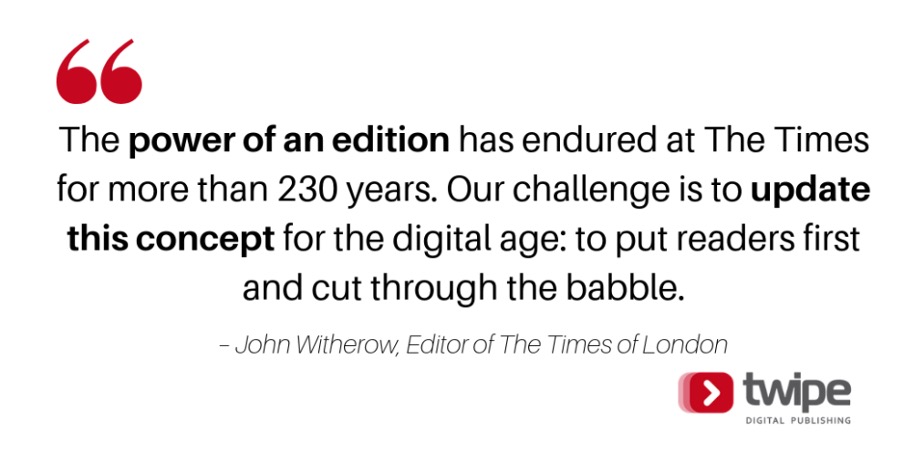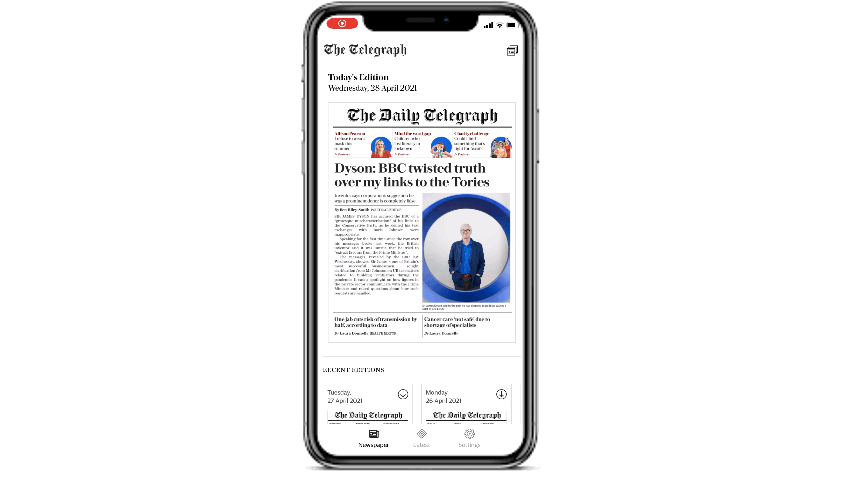Editions: The journalism product that has been driving habits for over 400 years
At Twipe, we often talk about the importance of habit formation in growing subscribers and retention. Habit formation is fundamental in building recurring behaviour and traits that lead to actions being adopted to parts of a daily routine. In publishing, there are several ways of building habits amongst readers. One such way is through the power of edition-based publishing. This is something we have been studying at Twipe with keen interest over the past 10 years.
We often get the question what exactly is “edition-based publishing” and how can it build habits? Today we try to provide some answers to these questions.
More on this topic will be debated in a panel discussion with leaders from AJC, Advance Local and Poynter in our next webinar on 8th June.
What is edition-based publishing?
Editions can take many forms. Typically, when we think of editions, we think of print newspapers. In a time of digital growth however, we have seen the need for editions to be adapted to the digital age. In an attempt to make this adaptation, we have seen experiments with a wider range of other edition-based products. These products include replica print editions, digital native editions and newsletters.

Unlike live news, edition-based publishing typically consists of an array of editorially-curated, carefully organised and relevant content. This content is released at specifically designated times designed to drive habits and fit in the daily lives and routines (the habitat) of readers. Readers therefore have more time to read their daily articles without them being lost in an ever-changing newsfeed. They can often too have access to previous editions to go back to articles that have been particularly interesting, or they didn’t have time to finish.
Edition attributes
The key attributes of edition products are vital in creating reader habits. They keep alive a journalism product that has been successful and innovated on for over 400 years. Some of these attributes are:
- Finish-ability
- Simplicity & structure
- Curation
Live news products update throughout the day with an infinite amount of content. This means that they are never truly finishable. The finishability of edition products means that readers know exactly how much time to put aside daily. By being able to consume an edition cover to cover, not only does one feel the genuine sense of satisfaction in having completed a task, but also one feels well informed and ready for the next edition update to further this knowledge. Finishability gets readers in the habit of knowing when and where they will consume their news, thus adapting their daily routine to accommodate this action.
By keeping a product simple and giving it a clear structure, readers know what to expect. This means that the audience knows what kind of product they will consume and how they will consume it. This is a key part of the habit formation loop. Habit loops are the brain’s way of automating tasks. Therefore, actions that drive habit formation have to be “simpler than thinking” in the words of Nir Eyal, author of Hooked: How to Build Habit-Forming Products . For newspaper readers, this structure and simplicity has allowed their brain to not have to take too many decisions about how and where to find the content and focus on reading.

Without too many stand out and lavish features, the edition-based product can fit into daily habitual routines. It can therefore have its place alongside other activities where newspapers are often consumed. These often include everyday moments such as breakfast or commuting. This simplicity also comes through the curation of editions.
Subscribers often choose their go-to news publisher based on editorial curation. The curation of edition products helps ensure readers get the best news from an angle that attracts them. This is crucial for paid for products where curation provides a valuable service of organising the information of the world in a way that the subscriber can consume. In doing this, the readers have trust in the news that they read. This trust develops a relationship with a product. It also ensures a reader gets the reward they are investing in which keeps the habit of going back to the same source. This trust in curation is vital and with set publication times, editorial teams have the time to strategically plan content for upcoming editions.
Be where your readers already are
The timing of edition-based publishing is key for habit formation. Some publishers, such as Le Monde, release one edition a day. Others, such as The Times, have multiple slots throughout the day. No matter how frequently editions are published, it is important that the timing is predictable. Predictability has been vital for digital growth at The New York Times.
Timing of the edition release links with targeting. Traditionally, editions are targeted at those craving their news early in the morning. Ensuring that distribution times are tailored to the existing habits of your readers however is key. These existing habits are often linked with location and taking advantage of this can see publisher better engage their readers. In other words, be where your readers already are!
This includes targeting readers during their daily commutes, in lunch breaks, or in the evening period to replace time spent watching TV. With the pandemic and the switch to home working, this has been a challenge for publishers. With the slow return back to normality however, the opportunities for publishers to leverage the return of the reader should not be missed and publishers should ensure that they have the right products to do this.
We have never seen more interest in digital newspaper edition reading. People are not only hungry for news, they are also looking for a good mix of analysis, infotainment and brainteasers included in their digital newspaper.
Danny Lein, CEO and Founder of Twipe
Some publishers, such as Le Monde, offer special early access to address the habits of readers. Early editions respond to the strong internal trigger of readers that are eager to know the news ahead of time. They also help to address different news habits. For example if the reader regularly does not have time to consume news in the morning, it is important to be able to offer new content in the evening for them.
Not only is the timing key for readers but it is also key for editors and newsrooms. By having a hard deadline for the day’s edition, journalists can better understand deadlines for their stories and editors for the content selection. This is vital in driving internal habits and ensuring that newsroom’s potentials are maximised to keep a high standard of quality journalism. Editions are the best place to consume high-quality journalism.
Edition’s hidden gems
Publishers also enhance the power of other features in editions which are particularly useful in building habits. One key habit driving tool is puzzles. Whilst puzzles may come across to many as just a bonus feature, their ability to drive recurring habitual behaviour is vital for retention strategies. Enhancing their power and maximising their potential offers significant benefits to publishers. With the answers of puzzles being posted in the following days edition, they drive very loyal retention habits. It’s no wonder that publishers such as The New York Times and The Guardian have separate puzzle apps!
At The Telegraph, puzzlers are amongst the most loyal readers and are key to their habit formation strategy. In their latest app built on Twipe’s NextGen edition platform, their readers can play puzzles directly in their daily edition. These puzzles are in the exact same place where they would be in the print edition and drive the habit even greater by giving familiarity with both print and digital products. Their readers can also access previous edition’s puzzles through their archive. The habitual nature of these puzzles is vital to edition strategies.

One example comes from The Telegraph who also drive habitual behaviour through WhatsApp audio briefings. Interestingly, The Telegraph found that WhatsApp briefing users are 12 times more likely to become paid subscribers!
The idea to introduce audio briefings came about through the trigger of alleviating boredom on the commute. Upon providing The Telegraph with their mobile number, readers are sent a daily briefing of all the main news of the day. This is designed to get subscribers to click to listen, meaning that they are prepared for the day ahead and know where to go in their edition to access more detail about the stories that they have heard.
Other Blog Posts

Stay on top of the game
Join our community of industry leaders. Get insights, best practices, case studies, and access to our events.
"(Required)" indicates required fields

